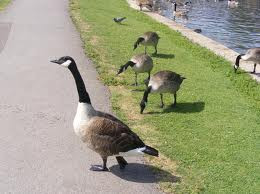Choosing the Right Deterrent for Your Bird Problem
Whether it’s geese gathering on the lawn, pigeons taking up residence on the roof, or swallows building nests under the eaves of a home, it’s no secret that birds can quickly become a nuisance, damaging property if the situation isn’t controlled.
Some birds, such as pigeons, crows, and gulls, are considered nuisance birds. They leave behind feces, which not only spread disease but can erode and stain building materials in a short amount of time. Luckily, there are bird control products available on the market that can deter birds and other critters from invading your property.
Bird control is not only important for homes, but also for businesses. Bird droppings can cause health issues in food processing plants, restaurants, and storage facilities, resulting in fines or even closures. The cost of cleaning up bird droppings quickly adds up to a huge expense for businesses as well. Not only that, there are potential liabilities for businesses plagued by bird infestation.
The first step in successful bird control is to connect with an expert who is familiar with the area’s bird population, their habits, behaviors, and their migrations, and also be knowledgeable and experienced in the best ways to address each type of bird problem.
Successfully deterring birds in a humane and environmentally responsible way is important. But before implementing deterrents, there are steps that should be taken:
• Determine the bird species, including their habits, sizes, and behaviors.
• Determine the weather conditions when the birds are present.
• Determine the location of the bird problem—building, pool, yard, or the specific area of the structure, such as the roof.
• The time of year that the birds appear is important.
• The time of day the birds appear—morning, afternoon, evening—is important as well.
Each Bird B Gone product addresses a specific bird problem, but sometimes there are multiple issues. For example, a business has a recurring issue with pigeons landing on gutters, building nests, and creating a back-up of standing water. One solution might be to install gutter spikes to prevent the birds from landing on the gutters. In addition, a Bird Spider 360 addresses additional issues of birds gathering on a building’s rooftop, lights, and AC units. This deterrent’s arms bounce as the wind blows, and the movement prevents birds, such as pigeons, from landing in the area.
Listed below are bird deterrent products that address specific problems experienced by home and business owners.
Electric Bird Tracks
These products work for businesses when birds are landing or nesting in areas where they don’t belong. The tracks can be installed on ledges, eaves, roof lines—on practically any service. When a bird lands on the track, they receive a mild electric shock that does not injure them, but trains them to avoid the area. This type of deterrent works with all types of birds including pigeons, sparrows, gulls, starlings and more.
Bird Spikes
These are available in both polycarbonate or stainless steel versions. Polycarbonate bird spikes are also available in seven colors, including a clear version, which makes them nearly invisible to passersby. The stainless steel bird spikes are manufactured with a UV protected polycarbonate base, and are available in the Mega version for larger birds, such as seagulls, raptors, vultures and pigeons; a Girder version that works well for larger birds and also includes aluminum clamps; and the Gutter option, which fits gutters up to ¾ of an inch.
Bird Netting
If the goal is to keep birds out of a specific area, then bird netting is the answer to the problem. Our netting is available in a heavy-duty knotted and no-knot version, and is strong enough to keep all bird species out of a covered area. Available in three colors, our heavy duty netting is nearly invisible, which is important to the aesthetics of any structure.
• Netting can also be beneficial in vineyards, orchards, and gardens to keep birds from feasting on the crops. Garden netting is available in bulk rolls or smaller quantities, in three different sizes of mesh, to keep out even the smallest birds.
• Bat netting works the same way as bird netting, but is installed to keep bats out of their known nesting places—eaves, bell towers, attics and canopies. Although bats are rodents, and only about 1 percent contract rabies, a buildup of their guano can cause odor and bug problems over time. The best solution is to prevent their access to structures in the first place. Most bats are either state or federally protected, and killing them is against the law.
• Industrial Pond netting can be used to prevent geese, and other birds from landing in a tailing pond. It is effective in keeping birds and other wildlife out of retention ponds, water collection sites, and hazardous oil pits or toxic situations.
Bird Slopes
Installing bird slopes on 90 degree ledges and I-beams prevents birds of all sizes from landing or roosting. When birds roost, they leave behind feathers and droppings. These droppings can damage stone and other materials, and degrade marble statutes. Pigeons especially love to roost on edges. A bird slope is a humane way to keep them from landing there.
Bird Wire
Ideal for deterring crows, gulls, and pigeons, bird wire is a series of posts that support a nylon-coated stainless steel wire. This product has been approved for both state and federal government structures. It is a discreet and cost-effective way to prevent birds from landing in an area.
Protect your home or business from costly clean up and potential structural damage from pest bird populations. Contact a specialist in bird deterrents who can help you identify the problem and suggest the right Bird B Gone products for you.

